Category: Event Recap
Audre Lorde’s New York
November 8, 2022
By: Amanda Davis
Last month, I participated in “A Celebration of Audre Lorde,” a virtual event that was hosted by the College of Staten Island. The evening was full of wonderful remembrances and discussions of Lorde and her work. This year marks a couple of anniversaries related to the self described “Black, lesbian, feminist, mother, poet warrior”: she moved to Staten Island 50 years ago with her family and, after a hard fought battle with breast cancer, she died 30 years ago this November 17th. (October was chosen for the event to coincide with Breast Cancer Awareness Month; it’s also LGBT History Month).
My portion of the evening focused on historic places on our website that connect to Lorde’s legacy. Here’s a little snapshot of Audre Lorde’s New York:
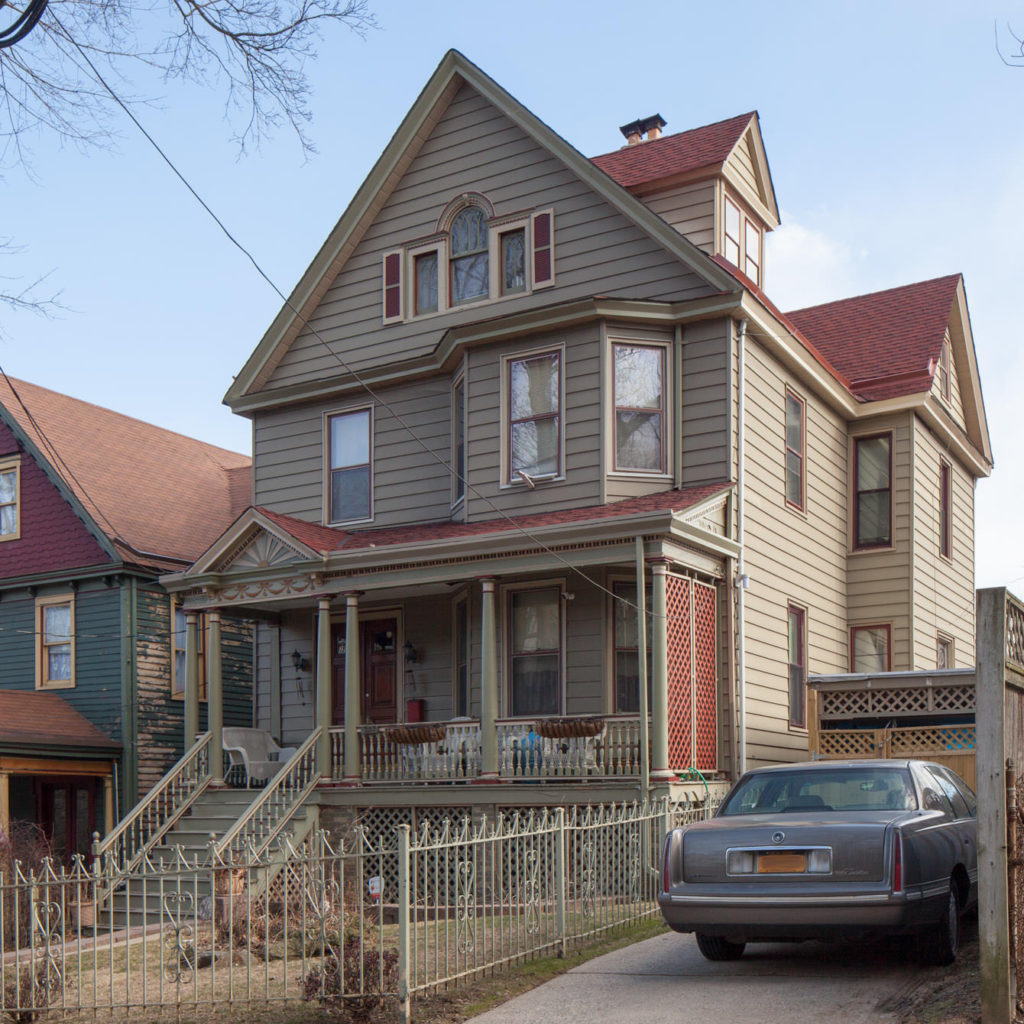
Audre Lorde bought this house at 207 St. Paul’s Avenue in Stapleton Heights in 1972 and lived here with her partner Frances Clayton and two children. The family unfortunately dealt with racism while living here but Lorde also noted that the home’s garden, trees, and proximity to the water were some of the reasons she chose to move to Staten Island. A photo taken by Joan E. Biren (JEB) shows Lorde writing away at her desk in her upstairs study. This is where she wrote some of her most famous work, including (but not limited to) Zami: A New Spelling of My Name (1982). She and her family lived here until 1987. Read more about Lorde’s connection with this house.
One of our Project’s goals is to expand the number of designated LGBT landmarks in New York City. In a meeting with the NYC Landmarks Preservation Commission (LPC), the city agency that designates and regulates the city’s landmarks, we advocated that this house, along with several others, become a New York City Landmark. After a public hearing in June 2019 — where we, of course, testified in support! — LPC commissioners voted to designate the house and five other sites, making Lorde’s home the first LGBT-related New York City Landmark outside Manhattan.
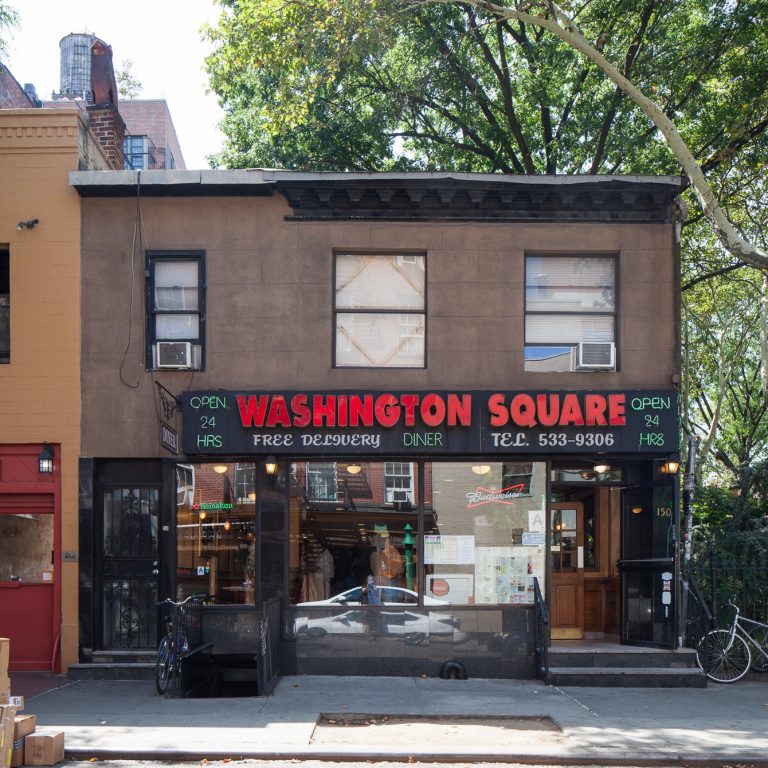
In Zami, Lorde wrote of several lesbian bars in Greenwich Village that she frequented in the 1950s, providing an invaluable account of nightlife in this period for lesbians in general and Black lesbians in particular. Of the Pony Stable Inn at 150 West 4th Street, she noted that “There were always rumors of plainclothes women circulating among us, looking for gay girls with fewer than three pieces of female attire. That was enough to get you arrested for transvestism, which was illegal.”
Bars historically were safe spaces for the LGBT community, but there were also risks involved. We’ve created a curated theme on Bar Raids and Forced Closures that puts this into context.
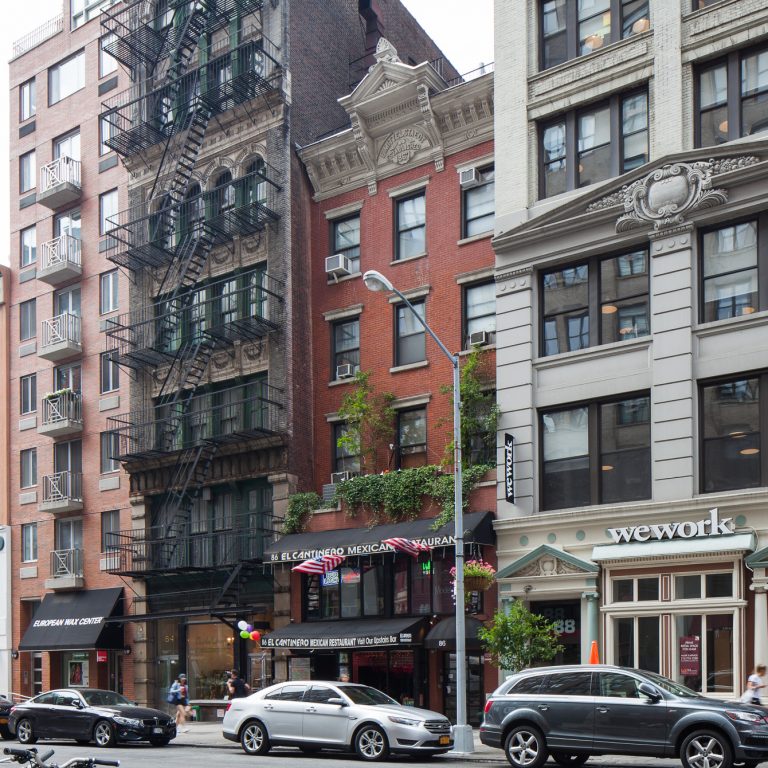
Several lesbian women we’ve spoken to fondly recall The Bagatelle at 86 University Place. Lorde referred to it in Zami as “the most popular gay-girl’s bar in the Village” but, at the same time, many Black lesbians did not feel welcome there. She recalled, “the bouncer was always asking me for my ID to prove that I was twenty-one…Of course ‘you can never tell with Colored people.'”
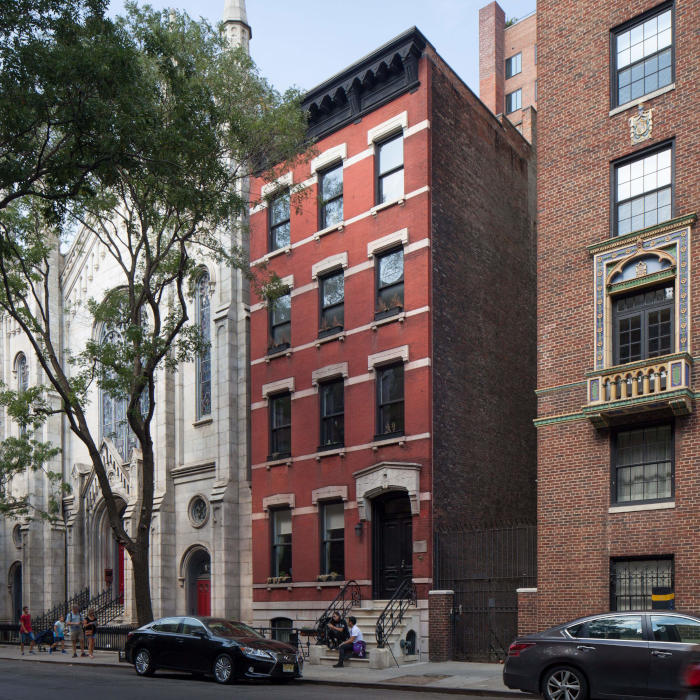
This is what made groups like the Salsa Soul Sisters so important to lesbians of color, providing an alternative to bars where they had historically faced discrimination. Black lesbian luminaries like Audre Lorde were invited to speak on various topics, creating a space that was rare for lesbians of color in 1970s America, according to member Candice Boyce.
The group grew out of the Black Lesbian Caucus of the Gay Activists Alliance, which met at the GAA Firehouse in SoHo in the early 1970s. Salsa Soul’s first regular meeting space was the Metropolitan-Duane United Methodist Church (now Church of the Village) but its longtime home was in the parish house of Washington Square Park United Methodist Church.
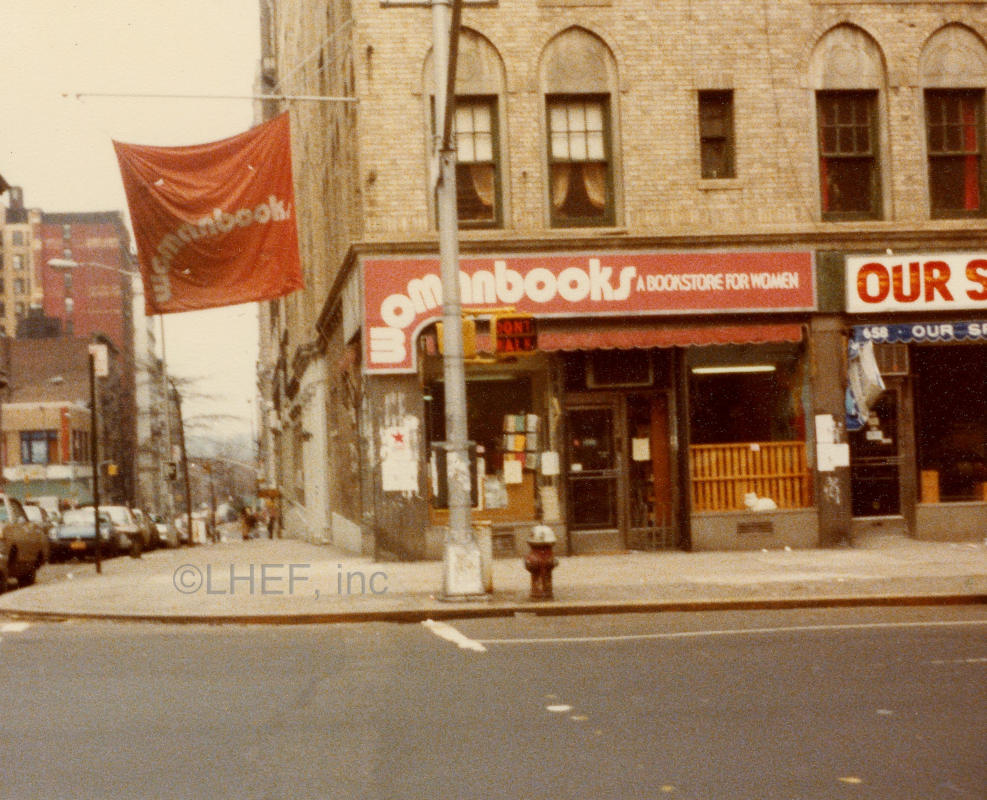
Let’s end with an archival photograph (always my favorite!) of Womanbooks, which was located at 201 West 92nd Street on the Upper West Side from 1975 to 1987. The bookstore doubled as a community center for women regardless of sexuality, race, or political affiliation, and was another one of several places in the city where Audre Lorde spoke to lesbian audiences.
What are some of the other places where she made her mark in the city? Type her name in the search bar at the top of the website or watch the recording of “A Celebration of Audre Lorde” below. Participants include faculty and students of the College of Staten Island, Debbie-Ann Paige of the Staten Island African American Heritage Tour, and Victoria Munro of the Alice Austen House who spoke with Lorde’s sister comrades.
PHOTOS: Off-Off Broadway at the Caffe Cino
October 25, 2018
On October 23, 2018, Caffe Cino historian and veteran Magie Dominic and Project manager Amanda Davis joined with the Greenwich Village Society for Historic Preservation (GVSHP) to host “Caffe Cino: Off-Off Broadway and On the National Register,” at the historic Judson Memorial Church. Together, they shared the history and magic of the Caffe Cino, a groundbreaking pre-Stonewall café theater.
Caffe Cino, located at 31 Cornelia Street from 1958 to 1968, was the creation of Joe Cino, an openly gay Italian-American producer who is credited with starting the “Off-Off-Broadway” theater movement. Caffe Cino was the first important venue to regularly stage Off-Off-Broadway productions, was critical in the development of gay theater, and served as a place of support for gay playwrights during a time when depicting LGBT experiences on stage was illegal.
Project manager Amanda Davis is the author of the National Register nomination for the Caffe Cino.
Thank you to our cohosts, GVSHP, to Magie Dominic and to all our guests, especially Obie and Tony Award-winning director Marshall Mason, a veteran of the Caffe cino.
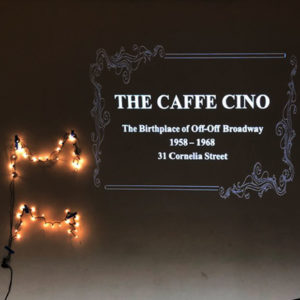
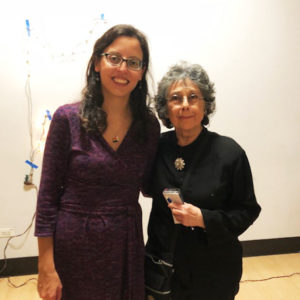
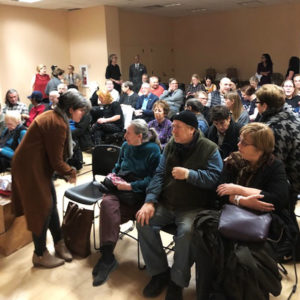
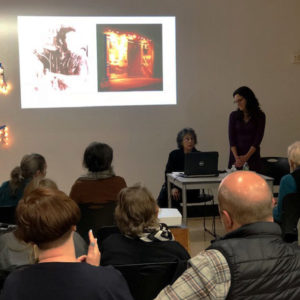
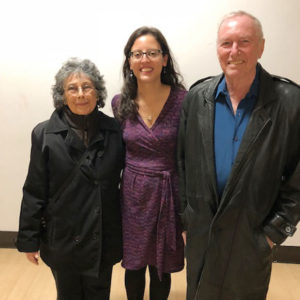
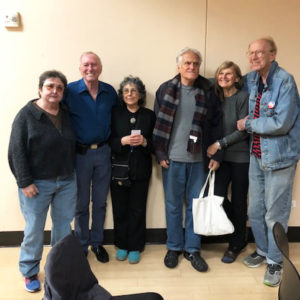

PHOTOS: LGBT advocates honor 52nd Anniversary of historic “Sip-In” with trailblazer Dick Leitsch and advocate/influencer Adam Eli
April 26, 2018
PHOTO RELEASE
PRESS CONTACT
Ken Lustbader, NYC LGBT Historic Sites Project
p: (917) 848-1776 / e: [email protected]
** PHOTOS **
Generations come together at LGBT anniversary event
LGBT civil rights trailblazers Randy Wicker, Dick Leitsch — mastermind
of 1966 Mattachine Society “Sip-In” — and new guard activist Adam Eli
share a toast a Julius’ Bar
New York, NY–LGBT advocates and NYC preservationists celebrated history on Saturday, April 21st, at Julius’ Bar in Greenwich Village, the site of the historic 1966 “Sip-In” organized by the Mattachine Society, an early American homophile group.
Trailblazer and mastermind of the “Sip-In” — one of the earliest acts of public resistance, which challenged discrimination against LGBT people in New York City — Dick Leitsch, as well as fellow Mattachine member and protest participant Randy Wicker, were joined by Adam Eli, whose own non-violent activism builds on the legacy of actions like the groundbreaking “Sip-in.”
Speaking to the standing-room-only crowd at Julius’, Adam Eli referenced the historic pendulum of progress in the community: “when the pendulum moves forward, it’s because we pushed it,” resisting periods of oppression and using our might to swing the pendulum back towards a period of increased rights and equality. “Tonight, honor your ancestors, thrive with your contemporaries and fight like hell on Monday,” he declared, in a moment (full speech here) which captured the spirit of inter-generational appreciation between pioneers Leitsch and Wicker and the young Eli, a force behind the activist group Voices4.

State Senator Brad Hoylman presented event organizers NYC LGBT Historic Sites Project and Julius’ Bar with a proclamation declaring April 21, 2018 to be “Julius’ Bar Appreciation Day,” in honor of Julius’ status as the “oldest LGBTQ bar in New York City still in operation” and the Sip-In’s status as “one of the first acts of gay civil rights disobedience in the United States of America.”
NYC Councilmember Daniel Dromm, Chair of the Council’s LGBT Caucus and himself a former teacher, praised the leadership of Dick Leitsch for his 1966 “Sip-In” and also the work of the NYC LGBT Historic Sites Project to document and disseminate LGBT history via its website, www.nyclgbtsites.org. Councilmember Dromm reinforced his support of LGBT history inclusion in public school curriculum.


View more photos of the
“Sip-In” 52nd Anniversary celebration (here).
Photos:
(1) Left to right, Helen Buford, owner of Julius’ Bar; NYC Councilmember Daniel Dromm; Dick Leitsch; Adam Eli, activist and social influencer; Jay Shockley, Project co-director; Randy Wicker; Ken Lustbader (with sign), Project co-director.
(2) Randy Wicker, participant of the 1966 “Sip-In” signs copies of the famous photograph by Fred W. McDarrah, of the Mattachine Society group being denied a drink by the bartender at Julius’.
(3) Dick Leitsch, mastermind of the 1966 Mattachine Society’s “Sip-In” joins with NYC LGBT Historic Sites Project manager Amanda Davis, donning a “Go-Go Mattachine!” button, for a fun photo.
(4) State Senator Brad Hoylman (right, with bowtie) presents a proclamation declaring April 21, 2018, to be “Julius’ Bar Appreciation Day,” in honor of its place in LGBT and American history.
Historical Background
Fifty-two years ago — on April 21st, 1966 — four homosexuals went in search of a drink. They had a purpose: to challenge discrimination against LGBT men and women at bars. At the time, the New York State Liquor Authority (SLA) enforced regulations making it illegal for bars to serve drinks to known or suspected gay men or lesbians, since their presence was considered de facto disorderly. The SLA regulations were one of the primary governmental mechanisms of oppression against the gay community because they precluded the right to free assembly. This was particularly important because bars were one of the few places where gay people could meet each other. Learn more about Julius’ as a site of LGBT history on our website (more).
At Julius’ Bar, they were refused service, the exchange with the bartender captured in a now-famous image by legendary photographer Fred W. McDarrah. Mainstream media took notice and what was called a “Sip-In” helped to change history.
As sites connected to LGBT history in NYC are threatened — the former site of the Paradise Garage has been demolished; 69 West 14th Street, site of the founding of the Gay Liberation Front, is actively threatened by the wrecking ball — it is more important than ever to remember the determination of LGBT equal rights pioneers and the physical sites which place key people and events in history.
About the NYC LGBT Historic Sites Project
The NYC LGBT Historic Sites Project is a cultural initiative and educational resource that is documenting historic sites connected to the LGBT community throughout New York City. Its interactive map features diverse places from the 17th century to the year 2000 that are important to LGBT history and illustrate the community’s influence on American culture. The Project is nominating sites to the National Register of Historic Places and developing educational tours and programs. For more, visit www.nyclgbtsites.org, or follow on Facebook, Twitter and Instagram.
###
Talking & Walking LGBT History in Chicago
20171120
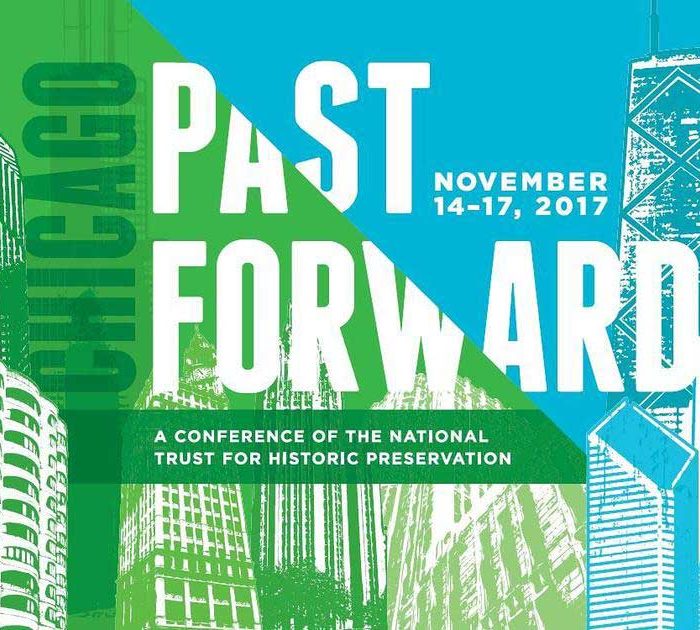
Last week our project manager Amanda Davis was in the great city of Chicago to speak at PastForward, the annual conference of the National Trust for Historic Preservation. Several diversity and inclusion sessions, which concentrated on historic preservation’s role in activism and social justice issues, were held at the historic Palmer House downtown. At the LGBTQ session, Amanda spoke about our Project’s efforts to nominate sites to the National Register of Historic Places, raise awareness of LGBT history through our online interactive map, and work with others in the community to advocate for the protection of these significant spaces. She was thrilled to hear from a number of attendees who are also working on (or hoping to start) similar projects throughout the country.
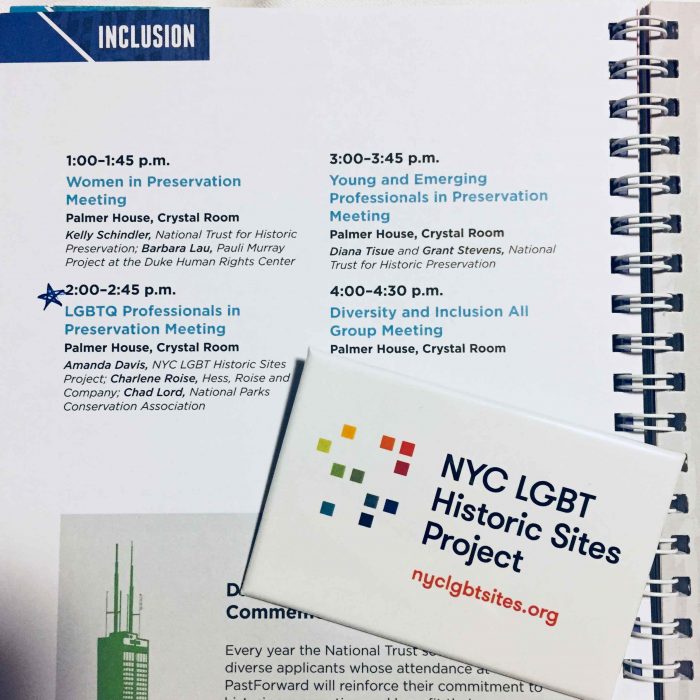
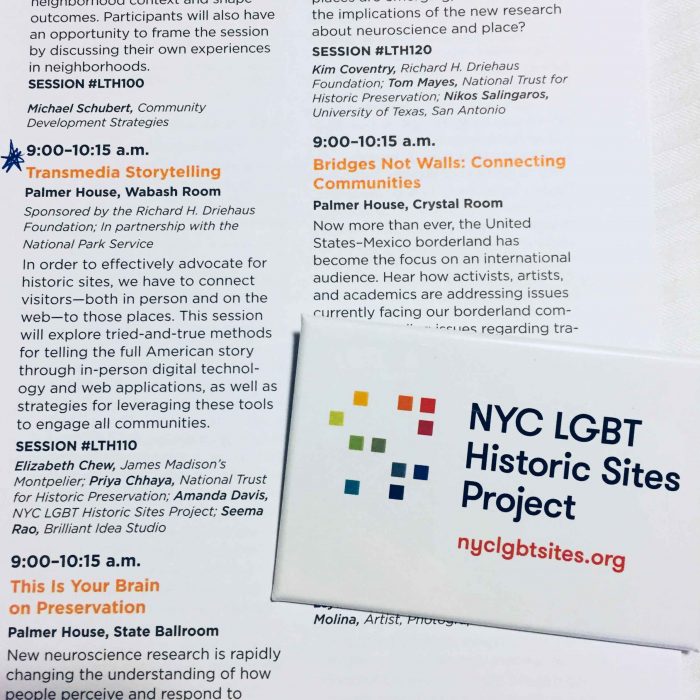
The following day, Amanda spoke at one of the conference’s Learning Labs, a panel discussion on the importance of using technology to engage the public with history. The session was also a wonderful opportunity to showcase how we as storytellers can reach more diverse audiences through different types of media, both online and in person.
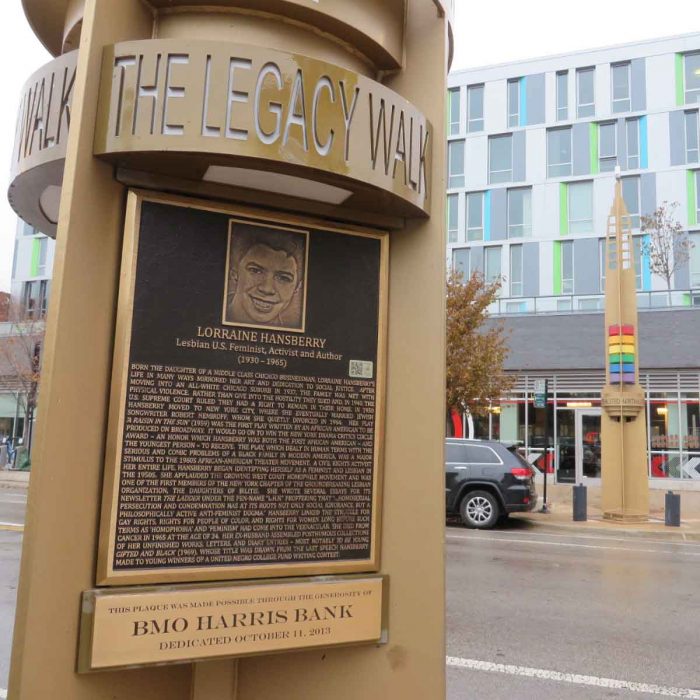
Amanda also had the chance to take the “El” up to Boystown, Chicago’s historically gay neighborhood, to see the Legacy Walk, billed on its website as “the world’s only outdoor museum walk, traveling installation, and youth education program dedicated to combating anti-gay bullying by celebrating LGBT contributions to history.” Located along several blocks of North Halsted Street – between Belmont Avenue and Grace Street – the commemorative project features bronze plaques of notable LGBT figures on “rainbow pylons.” New plaques are added every October 11th (National Coming Out Day). See the end of this post for more photos.
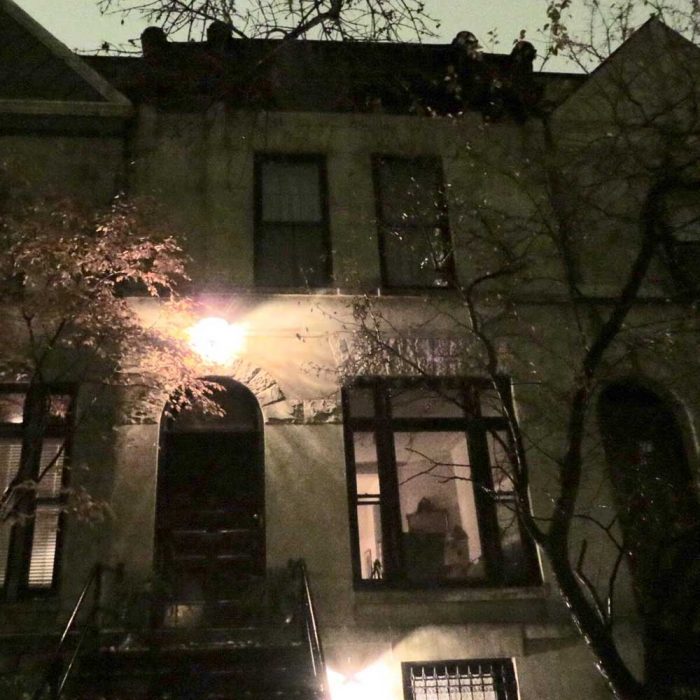
Before leaving Chicago, Amanda also stopped by the former Lincoln Park home of pioneering gay rights activist Henry Gerber. In 2015, the house was listed on the National Register of Historic Places and, in the same year, became only the second National Historic Landmark recognized for its significance to LGBT history (the first being Stonewall in 1999). Before Stonewall, the Mattachine Society, and the Daughters of Bilitis, Gerber founded America’s first LGBT rights organization – the Society for Human Rights – in 1920s Chicago. As a member of the US military he was also stationed (and faced harassment as a gay man) on Governors Island in New York City from the late 1920s to 1945.
Being able to talk about our work in Chicago, learn from others, and see some of the Windy City’s LGBT historic sites in person was a great treat. The Project looks forward to continuing the conversation at next year’s PastForward conference in San Francisco!
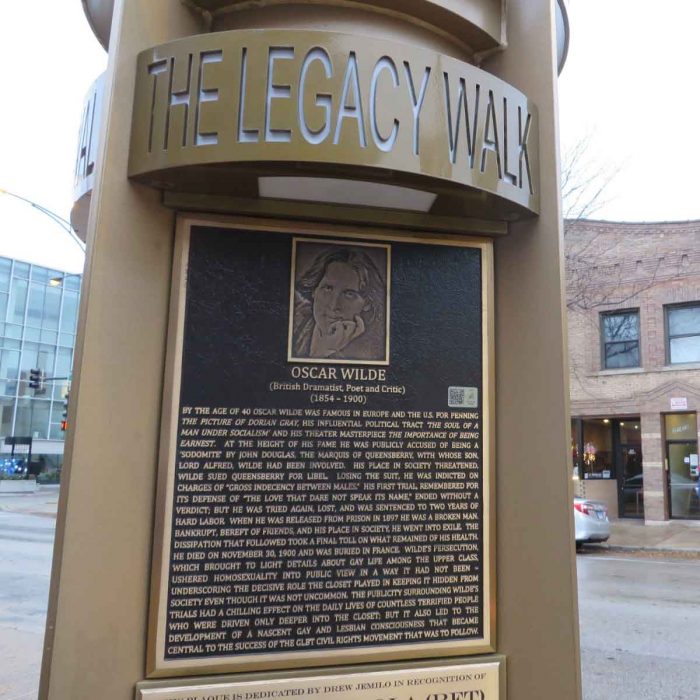
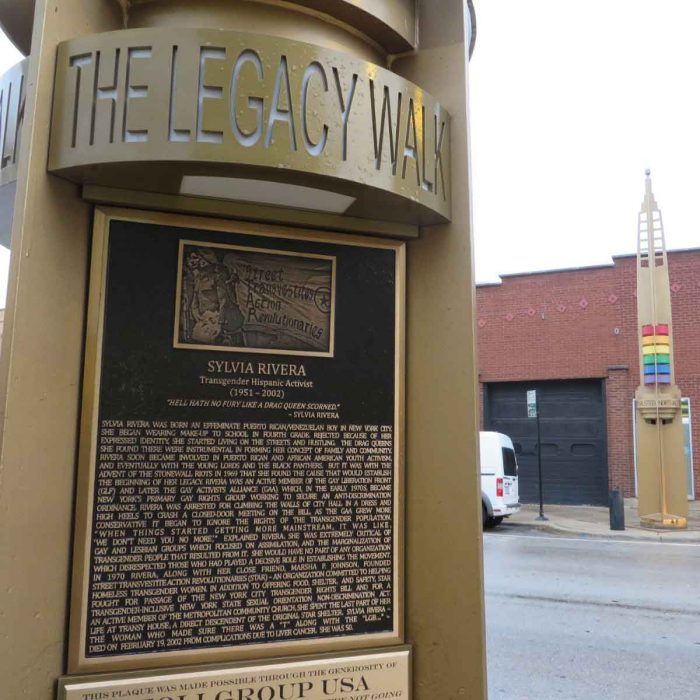
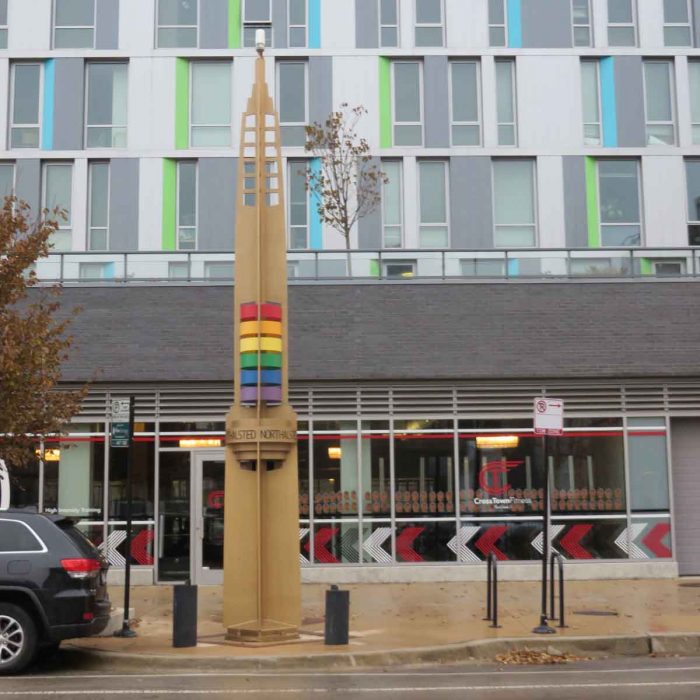
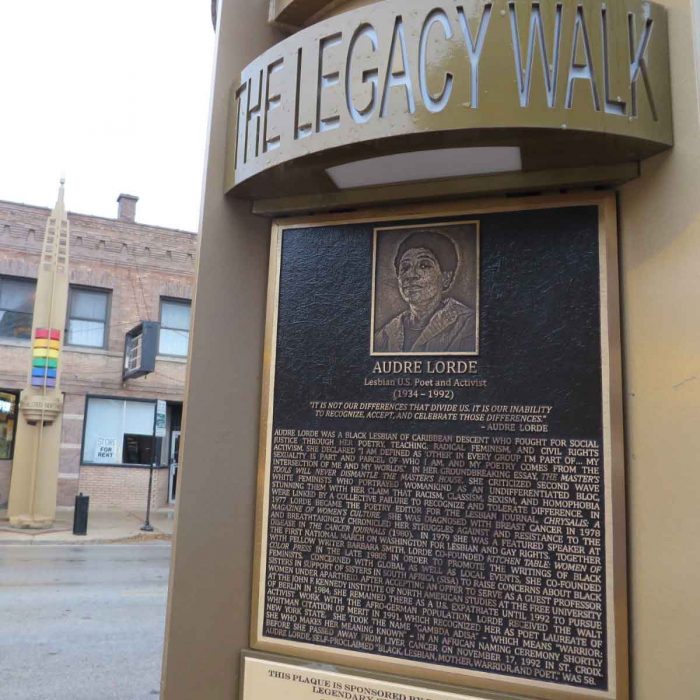
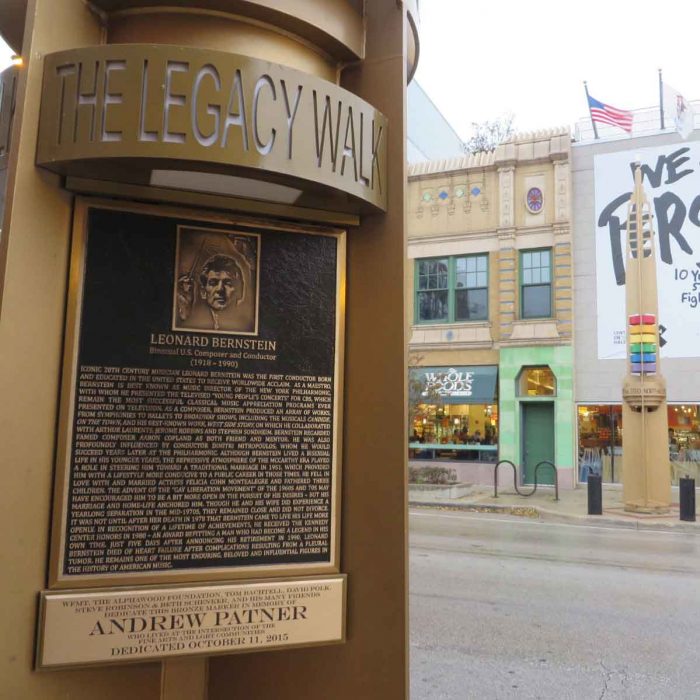
Multimedia
Hosted by Vimeo
Hosted by Soundcloud
Place and Community, a Discussion of Lesbian Nightlife and Culture
20171117 | 6pm
Amos Eno Gallery
56 Bogart Street, Brooklyn, New York
View on Google Maps
Sincere thanks to all who attended last night’s event, a conversation about lesbian nightlife and culture in NYC.
With artist Gwen Shockey‘s current exhibition “Addresses” as our backdrop, we joined with Stacy Lentz of The Stonewall Inn and Flavia Rando of Lesbian Herstory Archives for a discussion which touched upon spatial design, the geography of lesbian bars in NYC, the impact of digital media (dating sites in particular) on the culture of lesbian and queer bars and meeting spaces, and so much more.
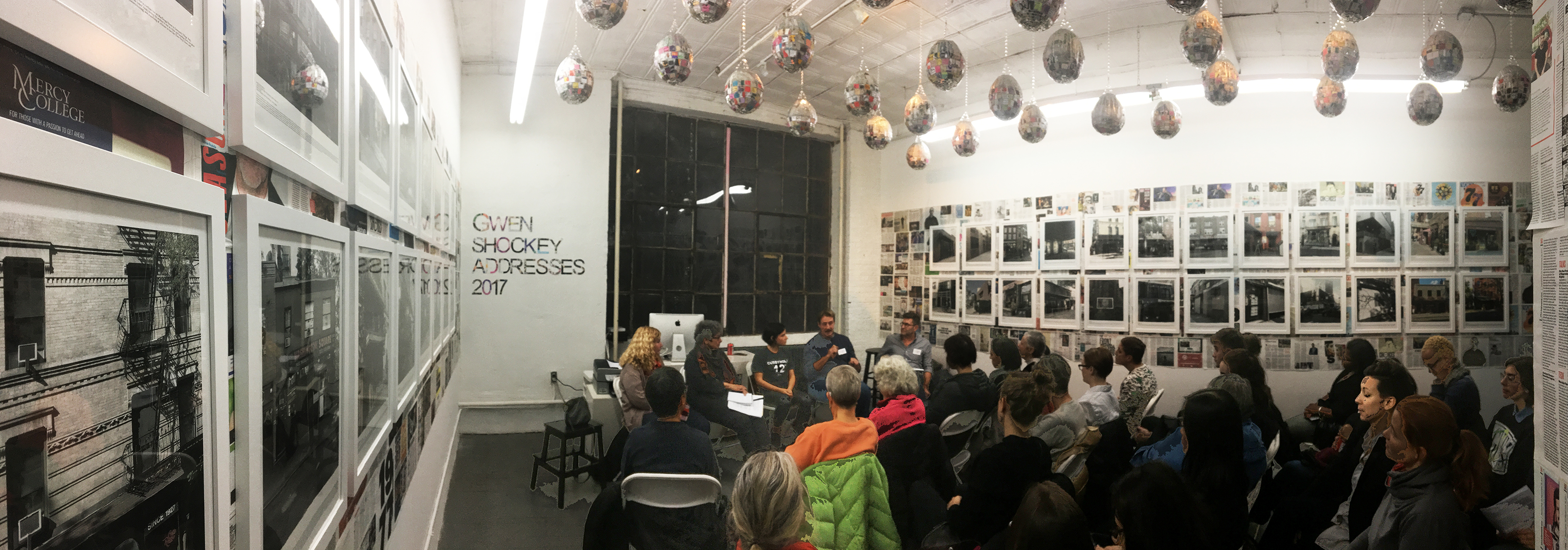
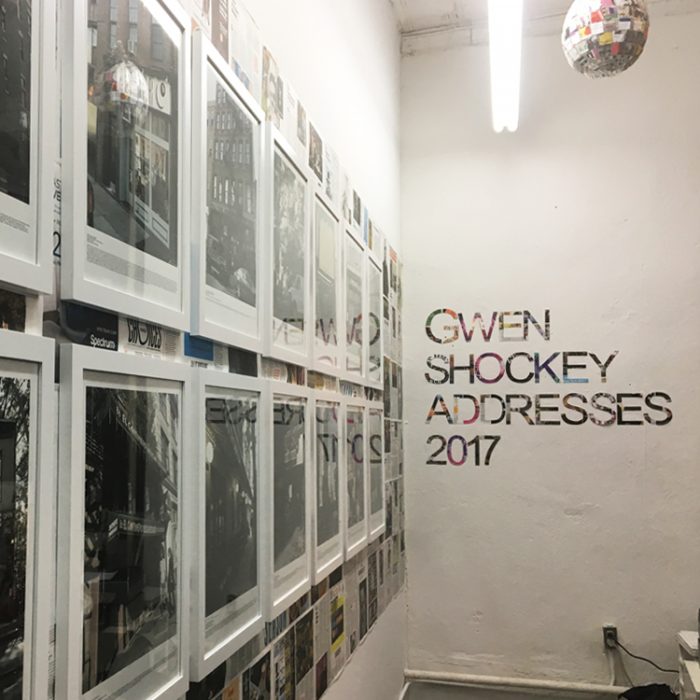
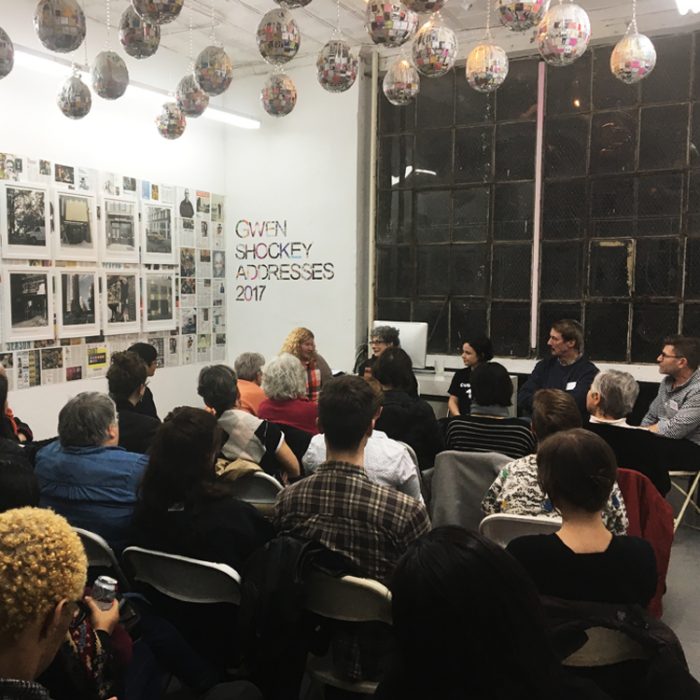
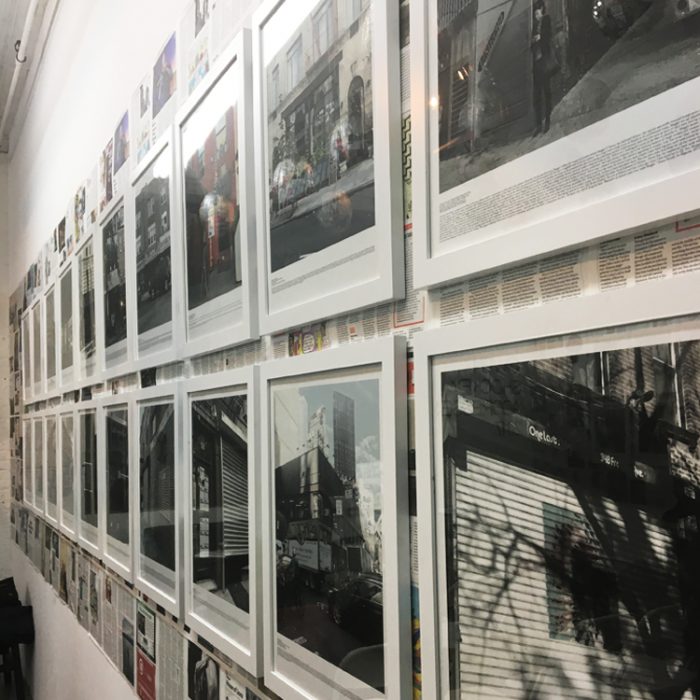
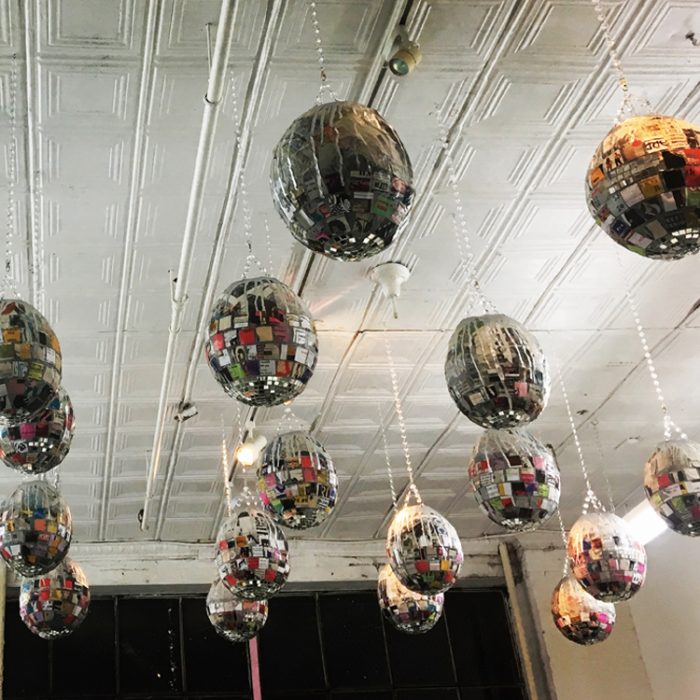
Trivia with “Making Gay History” Podcast for #NYPLAfterHours
June 24, 2017
On June 23, 2017, the New York Public Library hosted NYPL After Hours, a night inside the main library and dedicated to LGBT history and culture. Not only were we invited, Project adviser Eric Marcus of the podcast “Making Gay History” hosted LGBT-history trivia and Project manager Amanda Davis served as contributor, “fact checker” and a living bonus trivia clue!
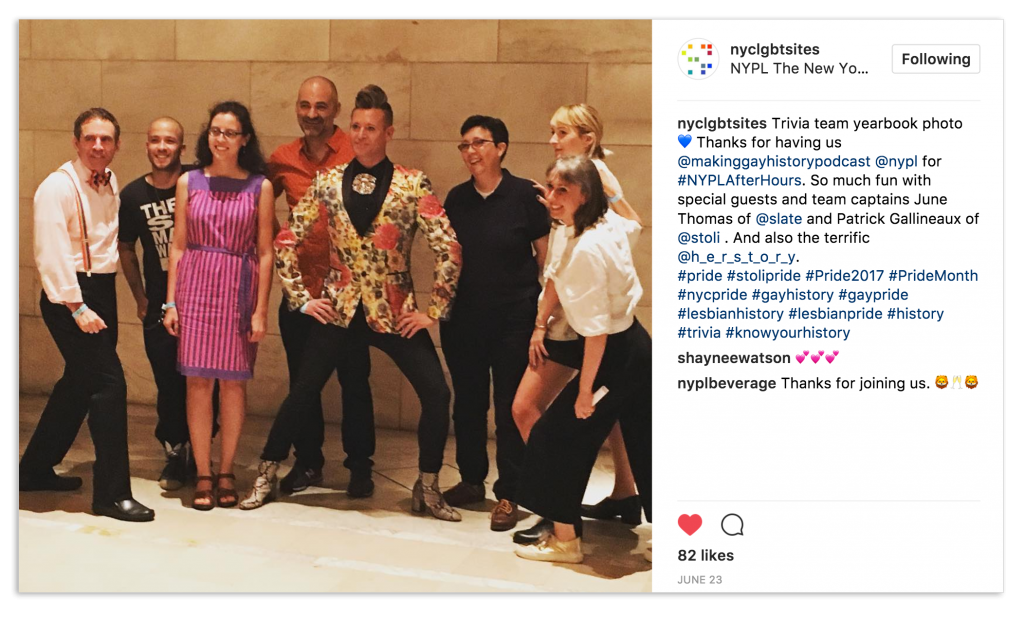
Related Links
Upper West Side Historic Sites
Alice Austen House, a National Register site of LGBT history
June 20, 2017
“The NYC LGBT Historic Sites Project is pleased to have amended the National Register listing of the Alice Austen House Museum / Alice Austen to reflect her importance to American photography and her 50 year relationship with Gertrude Tate. We’re working to ensure that these hidden narratives become known since LGBT history is American history.” — Andrew Dolkart, lead listing author and our co-director
This morning was marvelous as we gathered, on Staten Island, to celebrate the amended designation of the Alice Austen House Museum to include its significance as a National Register site of LGBT history — the first lesbian site in NYC to be listed on the register. Read the amendment, via the National Park Service.
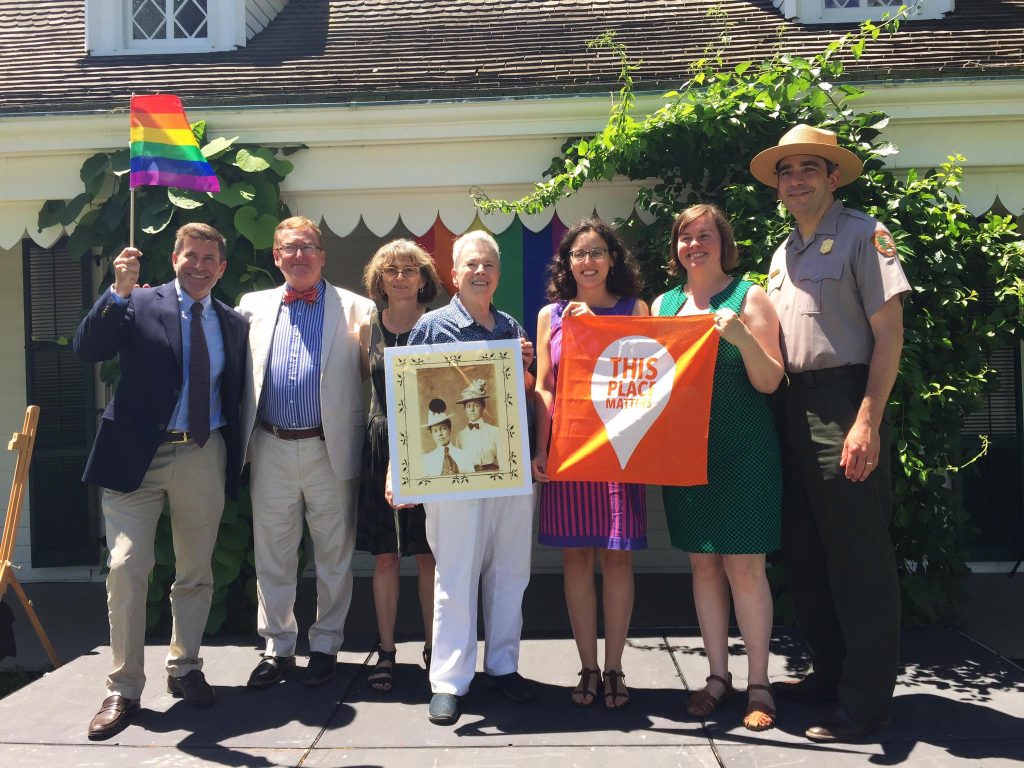
Pictured: Michael Lynch, Director of the Division for Historic Preservation Services, and Kathleen LaFrank, National Register Coordinator, both of the NYS Historic Preservation Office, NY State Parks & Historic Sites; Joan E. Biren, keynote speaker; Janice Monger, Executive Director of the Alice Austen House Museum; Joshua Laird, Commissioner of National Parks of New York Harbor; and the Project’s Ken Lustbader and Amanda Davis.
Presenting to Landmark West! on the Upper West Side
20161116
Yesterday we presented to attendees at an event sponsored by Landmark West! on the Upper West Side. We spoke about our LGBT preservation efforts since the 1990s (which led to the founding of our project in 2015), our project goals, and historic sites we have identified so far on the Upper West Side. Thanks to all who came and gave additional site suggestions.
If you have suggestions for LGBT historic sites on the Upper West Side (or elsewhere in the city), please fill out our form!
Related Links
Upper West Side Historic Sites
Looking Back on our First “Tenement Talk”
November 3, 2016
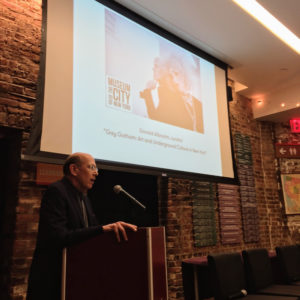
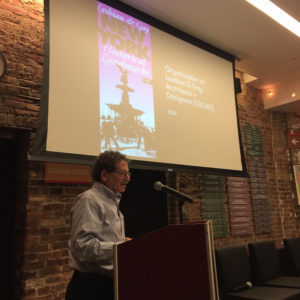
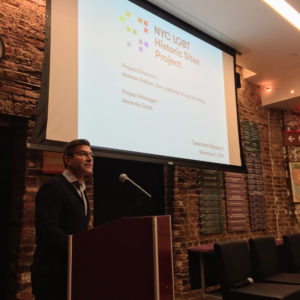
Last night we gave our first “Tenement Talk” at the Tenement Museum on the Lower East Side. We highlighted LGBT historic sites we have found in the neighborhood so far and also took site suggestions from the audience.
Donald Albrecht, curator of the “Gay Gotham” exhibition now on view at the Museum of the City of New York, introduced our talk.
Many thanks to the staff of the Tenement Museum for organizing this event!
Multimedia
[youtube id=”qqOzoQ0V7Rs” width=”600″ height=”350″ autoplay=”no” api_params=”” class=””][/youtube]
Hosted by YouTube
Related Links
Presenting at the New York Public Library
20160607
This evening we spoke about our project to a great audience at the New York Public Library, Stephen A. Schwarzman branch. George Chauncey (author of Gay New York) began the evening with a moving speech on the importance of the project’s goal to recognize LGBT historic sites, particularly for its potential to positively impact LGBT youth. Afterward, we shared historic sites that we’ve uncovered since our project launched last August, discussed our recent nomination of Julius’ to the National Register of Historic Places, and highlighted our pre-project efforts — beginning in the early 1990s — to document LGBT place-based history.
We’d like to thank Jason Baumann, Coordinator of Collection Assessment, Humanities, and LGBT Collections at the New York Public Library for coordinating this event with us and for helping us navigate the library’s extensive LGBT collections as we continue to uncover new sites across the city’s five boroughs.
Related links
Speaking at the LGBT Community Center
20160510
Tonight we gave a public presentation at the LGBT Community Center in Manhattan about our project and our recent nomination of Julius’ to the National Register of Historic Places. We can’t wait to start looking through the Center’s incredible archive!
Many thanks to Howard Williams for coordinating this event as part of the Center’s “Second Tuesday” lecture series.
Related Links
“Three Homosexuals in Search of a Drink”: The 50th Anniversary of the Sip-In at Julius’
April 13, 2016
Project directors Jay Shockley and Ken Lustbader joined Tom Bernardin in a panel discussion about the Sip-In at Julius’ last night at Jefferson Market Library. This was our first public program in Greenwich Village, a neighborhood that has a long and storied LGBT history. We took the time to highlight several important LGBT historic sites in the area and share other bits of information based on our 25 years of research. At the discussion, we were also thrilled to talk about our nomination of Julius’ to the National Register of Historic Places.
Many thanks to all who came and to the Greenwich Village Society for Historic Preservation for hosting this event! We look forward to speaking at future events in the Village.
Multimedia
[youtube id=”2U_IbeWNWp4″ width=”600″ height=”350″ autoplay=”no” api_params=”” class=””][/youtube]
Hosted by YouTube
Related Links
Event photos from the Greenwich Village Society for Historic Preservation
Speaking with Columbia Students
20160325
This evening we were invited by Columbia University’s Queer Students of Architecture, Planning, and Preservation (QSAPP) to give a presentation on our project, which was followed by a reception.
It was great to speak with the next generation of preservationists and architects about preserving LGBT historic sites.
Presenting to FIT Students
20151021
Today we made our first presentation to interior design students at the Fashion Institute of Technology. We look forward to meeting with more schools and universities in the future.